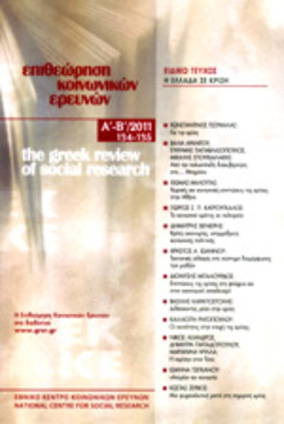The Screen of the Migrant Body : Technologies of Abjection and the “So-Called” Rape of Amarinthos
Part of : Επιθεώρηση κοινωνικών ερευνών ; Vol.140/141, 2013, pages 261-273
Issue:
Pages:
261-273
Parallel Title:
To σώμα της μετανάστριας ως οθόνη : Τεχνολογίες εκτοπισμού και ο «δήθεν» βιασμός της Αμαρύνθου
Section Title:
Articles
Abstract:
This article examines a seminal moment in the violent mediatized exposure of the female migrant body in contemporary Greek society: the 2006 video rape of astudent of Bulgarian origin in Amarinthos, Evia. This cyberbullying incident demonstrated how the contemporary exercise of gender and ethnic violence relies on technological practices of optical targeting, surveillance, spectacularization and voyeurism by sovereign citizens. After initial intense media coverage, however, the “truth” of the rape gradually came into question. As a process of abjection, therape transformed an immigrant neighbor, classmate, even girlfriend—a familiar stranger—into an abhorrent Other, whose inseparability from the self, in fact, is confirmed by this ongoing repudiation.
Subject:
Subject (LC):
Keywords:
gang rape, violence against migrants, abject body, visual technologies, cyberbullying, ομαδικός βιασμός, βία κατά μεταναστών, αποκείμενο (abject) σώμα, οπτικές τεχνολογίες, διαδικτυακός εκφοβισμός
Electronic Resources:
References (1):
- Agamben G., 1998, Homo sacer: Sovereign power and bare life, Stanford, Stanford University Press. Barthes R., 1972, Mythologies, New York, Farrar, Straus & Giroux. Bhabha H., 1994, The location of culture, London, Routledge. Butler J., 1990, Gender trouble: Feminism and the subversion of identity, New York, Routledge. —, 2004, Precarious life: The powers of mourning and violence, London, Verso. De Genova N., 2010, «The queer politics of migration: Reflections on “illegality” and incorrigibility», Studies in Social Justice, 4 (2), pp. 101-126. Diken B., 2005, «Becoming abject: Rape as a weapon of war», Body & Society, 11 (1), pp. 111- 128. Feldman A., 2000, «Violence and vision: The prosthetics and aesthetics of terror», in V. Das, A. Kleinman, M. Ramphele and P. Reynolds (eds), Violence and subjectivity, Berkeley, University of California Press, pp. 46-78. —, 2005, «The actuarial gaze: From 9/11 to Abu Ghraib», Cultural Studies, 19 (2), pp. 203-226. Hansen T. B., Stepputat F. (eds), 2005, Sovereign bodies: Citizens, migrants, and states in the postcolonial world, Princeton, Princeton University Press. Kristeva J., 1982, Powers of horror: An essay on abjection, New York, Columbia University Press. Puar J., 2004, «Abu Ghraib: Arguing against exceptionalism», Feminist Studies, 30 (2), pp. 522- 534. Sconce J., 2000, Haunted media: Electronic presence from telegraphy to television, Durham, N.C., Duke University Press. Trouillot M.-R., 1995, Silencing the past: Power and the production of history, Boston, Beacon. Παπαηλία Π., 2008, «Οι φωτογραφίες από το Αμπού Γκράιμπ: Το σκάνδαλο της “νέας” τεχνολογίας και η πολιτική του οπτικού ρεαλισμού», Σύγχρονα Θέματα, 102, σ. 69-81.




